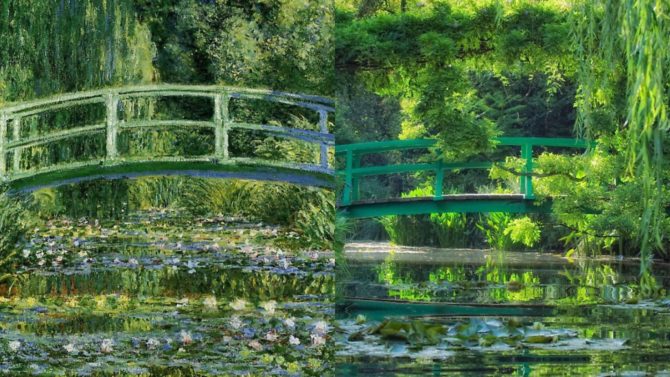8 famous paintings of France and their real-life inspirations
France has long been a muse for artists, but do the locations that inspired the likes of Monet and Van Gogh still look as picturesque today?

A Sunday Afternoon on the Island of the Grand Jatte, Georges-Pierre Seurat (1884-1886)
Then: The Île de la Grande Jatte, situated in the Seine between Neuilly and Levallois-Perret, has always been a mecca for painters. Although it started life as an industrial life, by Seurat’s time it was a real haven of calm away from the city.
Now: People still get together to recreate the famous painting on the shores of the island. Since 2009 there has been a trail around the island that you can follow to see the haunts of the impressionists. Nowadays it is also a popular home for celebrities including Richard Branson, Nicolas Sarkozy and actor Jean Reno.

Paris Street; Rainy Day, Caillebotte (1877)
Then: Caillebotte was a born-and-bred Parisian and one of the pioneers of the impressionism movement in the capital. This snapshot of the Carrefour de Moscou in the 8th arrondissement on a gloomy day is one of his best-known works.
Now: Renamed the Place de Dublin, the most notable difference between Caillebotte’s day and today is the presence of cars; the intersection is now a typically busy Parisian junction, unlike the peaceful spot for a stroll as it was in the 19th century.

Café Terrace at Night, Van Gogh (1888)
Then: Van Gogh moved to Arles in 1888 after two years in Paris. It was a very productive time, spawning this depiction of the Café du Forum and his first starry sky. He left Arles the following year to be voluntarily committed to the Saint-Rémy de Provence asylum.
Now: The Place du Forum was refurbished in 1990 to better replicate the scene from the painting. The café, now called Café La Nuit, is still a striking yellow and has the famous terrace.

Water Lilies, Monet (1897-1899)
Then: When Monet and his family moved from Paris to the village of Giverny in Normandy, one of his first tasks was to restore the overgrown garden to its former glory. He started painting the famous Water Lilies series in 1890 and was still adding the final brushstrokes to the canvases over twenty years later.
Now: Monet’s former home, now called the Fondation Claude Monet, is the second most-visited tourist site in Normandy, welcoming visitors from the world over to marvel at the beautiful garden. Visit the Fondation from the end of March until November; entry for adults is €9.50 and children €5.50.

Rue de l’Épicerie, Rouen, Pissarro (1898)
Then: Pissarro perfectly captures the buzz of the city and its lively market, dominated by the impressive towers of its gothic cathedral, in this series of paintings that he created on his fourth visit to the city.
Now: The cathedral continues to tower above the road today and the street is still filled with thriving independent shops such as butchers and greengrocers.

The Church at Auvers, Van Gogh (1890)
Then: Painted during the poet’s Nuenen period, when many say he really blossomed, Van Gogh’s image depicts the towering church in Auvers-sur-Oise. Van Gogh is actually buried in the town’s graveyard alongside his brother Theodore. Other artists who lived in the town at the time included Paul Cezanne, Pissarro and Daubigny.
Now: The church is a site of pilgrimage for Van Gogh fans and lovers of art in general. If you’re travelling to the Fondation Claude Monet, you can make a detour here. There is a Painter’s Pathway walk, taking you past other locations immortalised by the artist with plaques with the painting so you can compare it with the real view.

Boulevard Montmartre, Spring, Pissarro (1897)
Then: Pissarro painted a handful of pictures of the Boulevard Montmartre, one of Paris’ four grands boulevards, constructed in 1763. The road isn’t actually situated on the hills of Montmartre but rather is the easterly extension of the Boulevard Haussmann and the Boulevard des Italiens at their junction with Rue de Richelieu.
Now: The Boulevard is still Haussmannesque in appearance, although unlike in Pissaro’s painting, it is no longer lined with horses and carriages but with cars.

Mont Sainte-Victoire with Large Pine, Cézanne (c. 1887)
Then: Cézanne spent a lot of time in Aix-en-Provence, where the looming limestone Mont Sainte-Victoire straddles the départements of Bouches-du-Rhône and Var. The mountain was not just Cézanne’s muse; Picasso bought a château at the foot of the mountain and it’s been a source of inspiration for other artists and writers.
Now: In 1989 a fire ravaged lots of the mountain’s south face, destroying lots of the vegetation, and the result is still clear today. This doesn’t put off hikers; there are around 700,000 of them every year who tackle its slopes.
Liked this? You’ll also like:
Share to: Facebook Twitter LinkedIn Email




